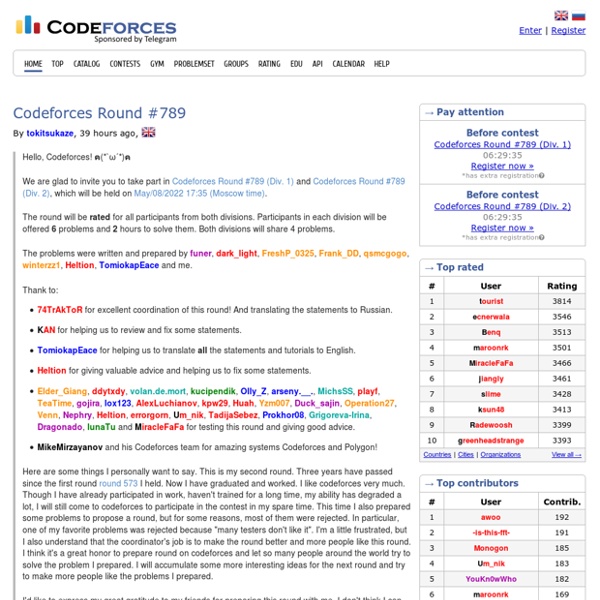



C, C++ Programming Tutorials Welcome! If you're new to C++, I recommend you purchase my ebook, Jumping into C++, a complete step-by-step guide for beginners. If you're looking for free tutorials, learn C++ with our C++ tutorial, starting at C++ Made Easy, Lesson 1 (all lessons) If you want to learn C instead, check out our C tutorial C Made Easy, Lesson 1 (all lessons) Want more advanced material on C, C++ graphics, game programming or algorithms? C++ Tutorial, C++ Made Easy: Learning to Program in C++ Learn C++ with this tutorial, designed for beginners and containing lots of examples, tips and simple explanations. C Tutorial - C Made Easy This tutorial is based on the above tutorial, but uses only standard C language features. More Advanced C and C++ Language Feature Tutorials [Top] C++11 - the new C++ standard C++11 is the new C++ standard, and it's chock full of goodness for C++ programmers, old and new. C++ Standard Template Library (STL) tutorials Understanding Floating Point Numbers by Jeff Bezanson By Ben Marchant
C++ Language Tutorial This website uses cookies. By continuing, you give permission to deploy cookies, as detailed in our privacy policy. ok Search: Not logged in C++ Language These tutorials explain the C++ language from its basics up to the newest features introduced by C++11. Introduction Compilers Basics of C++ Program structure Compound data types Classes Other language features C++ Standard Library Input/Output with files Tutorials C++ LanguageAscii CodesBoolean OperationsNumerical Bases C++ Language Introduction:CompilersBasics of C++:Program structure:Compound data types:Classes:Other language features:Standard library:Input/output with files Build Your Own External Hard Drive Step 1: Choose the right enclosure Many newer drives employ SATA, which uses a much smaller connector (above). Older IDE drives connect via two rows of pins (below). Consider two key factors when choosing an enclosure: size and interface. Size is easy: If the drive came from a desktop PC, it's probably a 3.5-inch model—though, if it dates from the late '90s, there's a small chance it could be 5.25-inch. Most notebooks, meanwhile, use 2.5-inch drives. Next, determine the interface your drive uses and look for an enclosure with a matching internal connector. For coverting an internal 3.5-inc IDE hard drive to an external unit, we used a $34.99 X-Craft 350 USB enclosure from Cooler Master. Next, consider the enclosure's external interface—how the box will connect to your PC. Other features to look for in an enclosure include a built-in cooling fan—highly recommended, especially if you'll leave the drive running for long periods. Step 2: Install the drive Tip: Don't rush.
Ruby Programming/Print version Ruby is an object-oriented scripting language developed by Yukihiro Matsumoto ("Matz"). The main web site for Ruby is ruby-lang.org. Development began in February 1993 and the first alpha version of Ruby was released in December 1994. It was developed to be an alternative to scripting languages such as Perl and Python.[1] Ruby borrows heavily from Perl and the class library is essentially an object-oriented reorganization of Perl's functionality. Mac OS X comes with Ruby already installed. Features Object Oriented Ruby goes to great lengths to be a purely object oriented language. Every class has a set of methods which can be called on objects of that class. Every object has a set of instance variables which hold the state of the object. Mixins In addition to classes, Ruby has modules. Dynamic Ruby is a very dynamic programming language. Variables in Ruby are dynamically typed, which means that any variable can hold any type of object. Singleton Classes Flexibility Variables and scope Blocks .
RaspberryPiBoard Notice: The Raspberry Pi Wiki pages on this site is collaborative work - the Raspberry Pi Foundation is not responsible for content on these pages. Now shipping to customers See the Buying Guide on how to order one, or visit the Raspberry Pi Foundation Home Page About The Raspberry Pi production board (model B Rev 2.0) 3D CAD Model of the Raspberry Pi 3 Model B (Download) The Raspberry Pi (short: RPi or RasPi) is an ultra-low-cost ($20-$35) credit-card sized Linux computer which was conceived with the primary goal of teaching computer programming to children. Raspberry Pi is manufactured and sold in partnership with the worldwide industrial distributors Premier Farnell/Element 14 and RS Components, and the Chinese distributor Egoman Technology Corp[1]. You can get the latest news from the Foundation Home Page, the Twitter Feed or in the forums. Products are RoHS, CE, FCC, CTick, CSA and WEEE compliant[2]. History Getting Started Resources Books Education Material Community About the RPi Wiki
Kidsruby.com